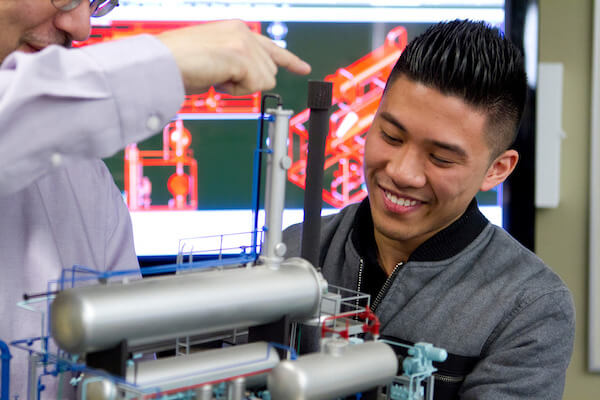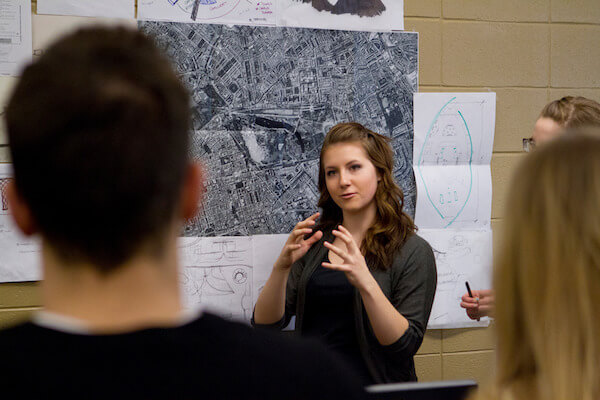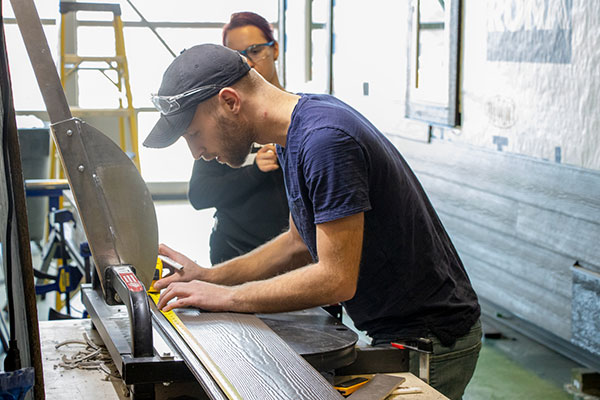On this page:
Overview
Our Civil Engineering Technology program forges professionals equipped to design, draft, cost, and manage the construction of various infrastructure projects, including buildings, roads, bridges, and more.
This two-year, intensive program offers hands-on learning combined with theoretical knowledge and the use of advanced technology. Embark on a journey encompassing all facets of civil engineering design and construction management, from foundational building science to 2D and 3D drafting, supported by the latest virtual and augmented technology.
Apply your learning in real-world construction engineering scenarios, mastering structural and geotechnical engineering principles, construction estimating, and project scheduling.
The program offers several intakes each year to accommodate your schedule. The program structure adjusts depending on your start date, allowing for semester breaks or continuous study with short breaks.
Ahead of your second year, you'll select one of three specialized majors - construction management, municipal, or virtual design and construction. While we'll do our best to accommodate your preference, selection for each major is determined by the cumulative grade point average (GPA) from your first year, should a specific specialization be in high demand.
Construction Management major
Construction Management majors learn how to:
- create detailed building designs
- accurately estimate project costs
- effectively manage the execution of construction projects from start to finish.
You'll be prepared for a variety of civil engineering jobs and roles in residential and commercial construction, from site management to project leadership positions. The curriculum is built with industry input, ensuring your acquired skills are relevant and sought after.
This diploma program is not just about gaining a credential. It's about building a career.
If you aspire to be at the forefront of the construction industry, innovating and leading in civil engineering design and construction management, this program is your gateway.
Those in civil engineering technology tend to be innovative, methodical, and directive.
You need:
- math and science skills, specifically an aptitude for physics
- organizational abilities
- an analytical mind
- problem-solving skills
- the ability to work alone
- the flexibility and commitment to work overtime when required to meet deadlines
- the ability to communicate effectively with project managers and contractors.
You should enjoy taking a systematic approach to your work, finding innovative solutions to problems, and providing direction to others.
Graduates of this program with a minimum 2.3 cumulative GPA (67% or C+) may apply for SAIT's Bachelor of Science Construction Project Management program.
You'll participate in a capstone project where you'll develop a proposal through research, data collection and analysis and present your findings to faculty and industry guests.
This program is nationally accredited, at the technologist level, by Technology Accreditation Canada.
Graduates are eligible to join The Association of Science and Engineering Technology Professionals in Alberta (ASET).
The Canadian Institute of Quantity Surveyors recognizes the program as training for qualified estimators and quantity surveyors.

After successfully completing this program, you'll receive a SAIT Civil Engineering Technology diploma with a major in Construction Management.
Careers and opportunities
Each year, SAIT conducts a survey between February and April to determine the employment rate, salary and satisfaction of our newest SAIT alumni.
![]() 84% graduate employment rate
84% graduate employment rate
![]() $60,000 average starting salary
$60,000 average starting salary
Find out more about our graduate employment statistics >
Our graduates may work in the following occupations. Some careers require additional experience and education.
Associated National Occupational Classification (NOC) codes: 22300, 22303, 70010, 21202, 22211, 22212.

Career planning support
Unsure which career path is for you? Here are some recommended career planning resources to help you decide your future.
You can also head to Alberta alis for lots of information about careers in Alberta, including quizzes and labour market information to help you narrow down a path.
Finally, you can take our online career finder quiz, which can help narrow your options based on your current skills and interests.
Courses
The Civil Engineering Technology diploma requires 61.5 credits (24 courses) to complete.
This program has fall, winter and spring intakes each year.
If you start in the fall, you'll study for two semesters per year with a summer break.
If you start in the winter or spring, you will study for four consecutive semesters and have one- or two-week breaks between semesters.
Civil Engineering core
| Course | Credits |
|---|---|
|
This course introduces students to the fundamental drafting techniques used in the Civil Engineering field. Students will first learn the basic functions of computer-aided design and drafting (CADD) and then use CADD software to create drawings related to the civil engineering field such as excavation cross sections, simplified roof framing plans, environmental site plans, subdivision plans and traverses. Pre-requisites:
|
1.5 |
|
This theory and lab-based course introduces the fundamentals of concrete technology starting with the ingredients and properties of concrete, and common terminology used to describe plastic and hardened concrete. Manufacture of Portland cement and the different types of Portland cement available in Canada are discussed, including Portland Limestone Cement. The classification and types of aggregates used in concrete are discussed along with their properties. Supplementary cementitious materials and chemical admixtures are introduced and their importance for concrete strength and durability reviewed. The culmination of the course will involve how to design a concrete mix for a specific application and exposure type. |
3 |
|
This is an introductory course in soil mechanics providing the fundamental characteristics of soils as an engineering material used in the design and construction of civil engineering projects. The topics include an overview of geology and groundwater, field investigation, calculation of soil properties, soil compaction and strength. The course also introduces the testing of soils using American Society of Testing Materials (ASTM) to determine standard soil properties. Pre-requisites:
|
3 |
|
In the Construction Practices course, you will examine various forms of construction, focusing on structures, with the aim of improving the standard and quality of design, construction and maintenance practices. You will also compare and contrast the characteristics of various systems of construction and components to set benchmarks for the selection of materials, components and systems as well as to select the appropriate equipment required to build them. Finally, you will develop a basic ability to read construction drawings which provide the details needed to build a specific structure. Equivalents:
|
3 |
|
This course is designed to develop technical writing and presentation skills to ensure workplace readiness. Students will learn how to evaluate communication situations, analyze documents, assess research sources and develop organizational skills to apply in their work. They will learn about and practice designing, formatting and writing a range of professional documents. Students will also develop confidence (through practice) in the development and delivery of effective and engaging presentations. Equivalents:
|
3 |
|
This applied computer course provides students with critical electronic communications, data and file management skills, along with a strong focus on using common productivity applications to format, calculate, analyze, visualize, and present or report data and information. Equivalents:
|
1.5 |
|
The course involves preparation of quantity takeoffs for excavations, foundations, site services, residential concrete, formwork, wood framing and finish carpentry, interior and exterior finishes. Students will complete a full estimate of a residential project including quantity takeoff, pricing, summary and bid preparation. |
3 |
|
This course enables the student to apply the basic knowledge of algebra and introductory calculus to resolve applied scientific and technological problems. Applications include linear motion, areas under curves, and volumes of revolution. Equivalents:
|
3 |
|
This course gives an introduction to material properties and the methods of analysis used in structural design. Students will learn the concepts of normal stress and strain, shear stress and strain, thermal stress and strain, deformation, and torsional loading. Structural elements will be designed based on material properties and factors of safety. Students will calculate sectional properties such as centroids and moments of inertia and construct shear force and bending moment diagrams for statically determinate beams. Calculation of flexural stresses, longitudinal shear stresses, and deflection will allow beam sections to be selected for structural applications. Column analysis and design are included. Pre-requisites:
|
3 |
|
STAT 245 is an introductory course in data analysis for students in engineering technology programs. Students apply techniques to organize, display, analyze and report data. Outcomes include methods of descriptive and inferential statistics. Students will be exposed to software-based methods in laboratory sessions using industry-grade data. Some advanced topics of analysis are selectable toward the end of the course. |
3 |
|
This course provides foundation skills in the analysis and design of structural and civil engineering applications. Students will analyze civil engineering structures containing simple coplanar force systems using the concepts of static equilibrium, force components, moments, free body diagrams and centroids. Students will also determine the support reactions for statically determinate beams and in two-dimensional pin-connected systems such as frames and trusses. |
3 |
|
This course focuses on an introduction to surveying including measurement of angles, distances, and performing traverses. Students will learn to calculate 3D coordinates of surveyed points as well as stake-out points extracted from design drawings. |
1.5 |
Construction Management core
| Course | Credits |
|---|---|
|
The Contracts and Regulation course introduces you to the concept of contracts in construction, the legal aspects of a binding contract, major terms and conditions, the standard terms and the CCDC forms of contract, various contract types, and tort law. The course further introduces the Occupational Health and Safety Act, and the National and Alberta Building Codes, which are commonly used in the construction industry. You will also look at various case studies of the actual disputes that became the basis of Canadian Court Decisions. |
1.5 |
|
The Project Planning and Control course introduces you to the process of planning a project for successful implementation. You will explore tools used in the construction industry for understating and organizing a project, identifying required parties, manage risk, apply methods to manage people and protect the public. Pre-requisites:
|
3 |
|
This course includes stress distribution, effective stress and consolidations, testing consolidation, shallow and deep foundations, lateral earth pressure, the design of retaining walls and mechanically stabilized earth, slope stability, site inspections, instrumentation. Pre-requisites:
|
3 |
|
This course focuses on the first principles of a buildings envelope and building science. An emphasis is put on buildings and people, building materials, heat transfer and basic building envelope design through the understanding of principles moisture movement and control the control of heat flow, water vapour and air leakage in buildings. Introduction to the basic principles of building operation through mechanical, hot water heating, plumbing, and electrical systems. Students perform lab and drafting exercises to demonstrate their ability to apply building science, systems principles and sound building construction techniques through infrared Thermography, building investigations and energy efficient buildings. Pre-requisites:
Equivalents:
|
3 |
|
This course is intended to provide students with the skills and knowledge required for effective design of steel buildings using Canadian Limit States Steel Standard CSA S16. This course covers the mechanical properties of steel, the philosophy of limit state design, the computation of the design loads from the National Building Code of Canada, and the design of tension members and cables, compression members and columns, beams, beam-columns and bolted and welded connections according to of the CSA S16 standard. Pre-requisites:
Equivalents:
|
3 |
|
Learners will analyze, design and detail reinforced concrete sections for building elements, including beams, columns, slabs and foundations using limit states design. The course will also cover field inspections for concrete reinforcement and reading structural drawings. Pre-requisites:
|
3 |
|
The objective of Construction Economics is to enable the decision-maker to make more informed decisions about the financial viability of a project and account for the economic impact of choices made in the design and construction phases of a project. Students will complete an economic analysis of project alternatives using present worth, capitalized cost and rate-of-return evaluation; assess the feasibility of alternatives based on benefit/cost and break even analysis; prepare a cost analysis of a building project using elemental analysis, life-cycle costing and a budgetary cost control system; and examine contractors' cost control systems. |
3 |
|
This course will extend your knowledge and abilities in structural behaviour and design. It will enable you to understand the behaviour of timber structures subjected to different loads. In this course, you will develop skills for the design of wood sections using limit states design including beams, columns, tension members and connections. The techniques and skills gained in this course will prepare you for engineering practice. Pre-requisites:
Equivalents:
|
1.5 |
|
This is an introductory course for civil engineering technologists that discusses environmental engineering solutions and environmental management. Topics presented include an introduction to environmental issues and impacts associated with civil engineering projects, contaminants and waste, environmental site assessments and site characterization; site remediation; risk assessment and management, water and wastewater treatment; landfill design and operation; site remediation and environmental stewardship; and sustainable design. |
1.5 |
|
This course involves preparing cost estimates of building construction projects using computer estimating software, as well as measuring earthwork, concrete, reinforcing steel, structural steel, carpentry work and envelope work. In addition, the course will cover pricing general contractor's work and sub-trade work including materials, equipment and labor crew productiveness, and pricing construction equipment. This course requires students to prepare a commercial cost estimate and demonstrate the process of completing an entire project bid. Pre-requisites:
|
3 |
|
PROJ 386 provides the Civil Engineering Technology students with the opportunity to demonstrate their problem solving, critical thinking and collaboration skills when producing a capstone project relevant to the civil engineering program. Students define a situation through research, data gathering and analysis to deliver an applied technology project. Students are required to prepare a formal technical report and verbally defend the project outcomes in compliance with the Technology Accreditation Canada (TAC) requirements. Pre-requisites:
Equivalents:
|
3 |
|
This course introduces students to advanced surveying techniques and their applications in Civil Engineering. The course focuses on the use of photogrammetry, and LiDAR. Additionally, the student will learn to process surveying data and estimate earthworks for different Civil Engineering projects. They will learn the fundamental applications of common Geographic Information Systems (GIS) and its applications. The student will apply the GIS principles using software to manipulate spatial/non-spatial information and create different terrain visualizations. Pre-requisites:Manual Prerequisite
|
1.5 |
Progression
You must attain a PGPA and/or a CGPA of 2.0 or better each semester and pass the prerequisite courses to progress through the program.
To qualify for graduation, you must pass all courses, attain a CGPA of 2.0 or better and complete course requirements within the prescribed timelines.
Review our grading and progression procedure >

Explore your options!
Some courses in this program are available through Open Studies. You can complete courses via Open Studies to get a head start on your education, reduce your course load once accepted into a credentialed program, or determine which career path best suits you before you fully commit.
You may also take courses for general interest or personal and professional development.
Admission requirements
Applicants educated in Canada
All applicants must demonstrate English language proficiency and meet the following requirements or equivalents:
- at least 60% in Math 30-1, and
- at least 60% in English Language Arts 30-1 or at least 75% in English Language Arts 30-2, and
- at least 60% in Science 30 or Physics 20.
SAIT accepts high school course equivalents for admission for applicants educated outside Alberta.
All applicants who were educated outside of Canada must demonstrate English language proficiency and provide proof they meet the program admission requirements outlined above with an international document assessment. Find accepted educational documents and assessment options.
SAIT may also accept courses completed at certain international post-secondary institutions.

Academic Upgrading
Missing an admission requirement for this program? Upgrade your prior education to help you receive admission into one of SAIT's career programs.

English language proficiency
All applicants must demonstrate English language proficiency prior to admission, including students educated in Canada.
Transfer agreements
At SAIT, we have created transfer agreements with partner institutions to allow you to earn course credits toward your SAIT program based on your previously completed credentials.
Transfer Alberta search tool
Use the Transfer Alberta search tool to see all transfer agreements between Alberta post-secondary institutions (including those with the University of Calgary, Mount Royal University and Bow Valley College.)
Search transfer agreements in Alberta
There are no formal transfer agreements currently in place for this program.
Transfer options for graduates
When you have completed this program, you may continue your education at a partner post-secondary institution. These transfer agreements include partnerships within and/or outside of Canada.
Credits this program transfers to
- Available credits:
- 60
Graduates of this program are eligible to apply for the Fall intake (September to April) Civil Engineering Bridge program offered by Camosun College, provided all admission requirements are met.
Successful completion of this bridging program will provide access to the third year of the University of British Columbia's (UBC) Bachelor of Applied Science in Civil Engineering program (September) at UBC's Vancouver or Okanagan campus.
- Available credits:
- 60
The Faculty of Engineering at Lakehead University offers post-diploma programs which enable qualified engineering technology graduates from accredited Canadian technology programs, including those from SAIT, to obtain engineering degrees.
The post-diploma programs consist of two years of full-time study preceded by transition courses in July and August.
Available intakes
Fall 2025
Start dates:
- Domestic students: Open
-
-
Application deadline: June 30, 2025
-
- International students: Open
-
-
Application deadline: May 30, 2025
-
Winter 2026
Start dates:
- Domestic students: Open
-
-
Application deadline: Oct. 24, 2025
-
- International students: Open
-
-
Application deadline: Sept. 26, 2025
-
Costs
2025/26 tuition and fees
The following costs are effective as of July 1, 2025.
The estimated total cost of tuition and fees is based on the suggested schedule of study. Following a modified schedule will impact the fees you pay per semester and may alter final costs.
Domestic students
The program total is based on the estimated amount you will pay if you enter this program during the 2025/26 academic year. The program total amount listed on your letter of admission may appear higher. This amount is your maximum tuition guarantee for the program. SAIT will not exceed this maximum, regardless of changes in tuition and fees between academic years.
Books and supplies are approximately $1,000 - $1,500 per full-time year.
This is a bring-your-own-device program with power-user computer hardware and software requirement. See the specific requirements on our computers and laptops page.
Textbooks and reading materials will be discussed with your instructors during the first week of classes.
Required personal protective equipment (PPE)
The industry-approved PPE you'll need will be discussed during your first few days of classes.
You'll need CSA-approved, above-ankle steel-toe boots, a hard hat, and safety classes for labs and site visits.

Financial aid
Paying for your education may feel overwhelming, but we have resources and programs that can help, including information about payment options, student loans, grants and scholarships.
Application process
When applying in the application portal, select Civil Engineering Technology. You will declare your major before your second year of the program.
Ready to apply?
Follow our step-by-step guide to submitting a successful application.
Communication during admission
Email is the primary source of communication during the selection process. Ensure your personal email account is managed appropriately to receive our emails, files and communications. We recommend you add the construction.advising@sait.ca domain to your safe senders' list or you risk missing critical email messages.

Begin your application
Apply now using the online application portal.
Ensure you have a valid Visa or Mastercard to pay the non-refundable application fee of $120 for domestic applicants or $175 for international applicants.
Information sessions
Prepare for a strong start in your chosen program or get the details you need to decide your future path.
Our expert staff and faculty are ready to answer your questions and provide information about the following:
- What sets SAIT apart
- An introduction to the program and area of study
- Admission requirements
- Future career paths
- Information on the earning potential and graduate employment rates.
Contact us
Prepare for a strong start and get the details you need to make a decision about your future. Our expert staff and faculty are ready to answer your questions, and provide information about:
School of Construction Advising
-
Phone - 403.284.8367
International Student Advising
-
Phone - 403.284.8852
-
Email - international@sait.ca
Subscribe for updates
Your journey starts here! Sign up to get important updates on:
- Business and leadership programs
- Application information
- Relevant news and events

Oki, Âba wathtech, Danit'ada, Tawnshi, Hello.
SAIT is located on the traditional territories of the Niitsitapi (Blackfoot) and the people of Treaty 7 which includes the Siksika, the Piikani, the Kainai, the Tsuut’ina and the Îyârhe Nakoda of Bearspaw, Chiniki and Goodstoney.
We are situated in an area the Blackfoot tribes traditionally called Moh’kinsstis, where the Bow River meets the Elbow River. We now call it the city of Calgary, which is also home to the Métis Nation of Alberta.




